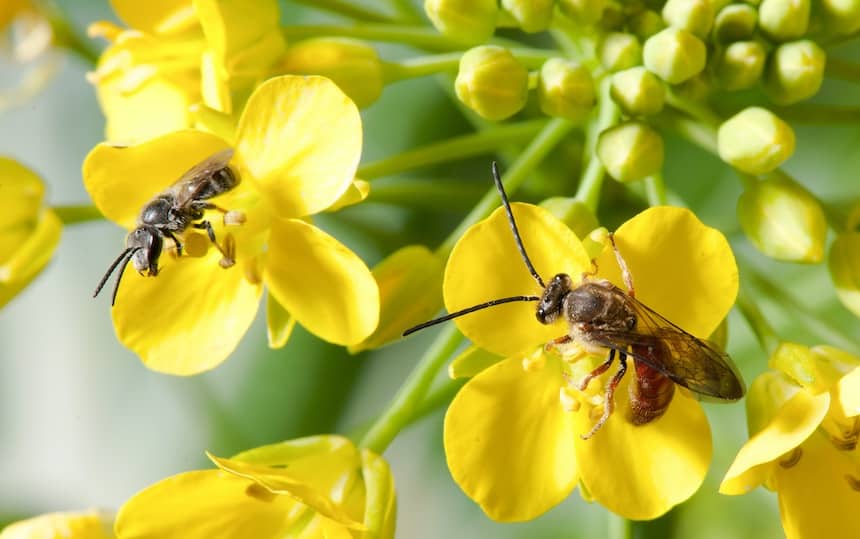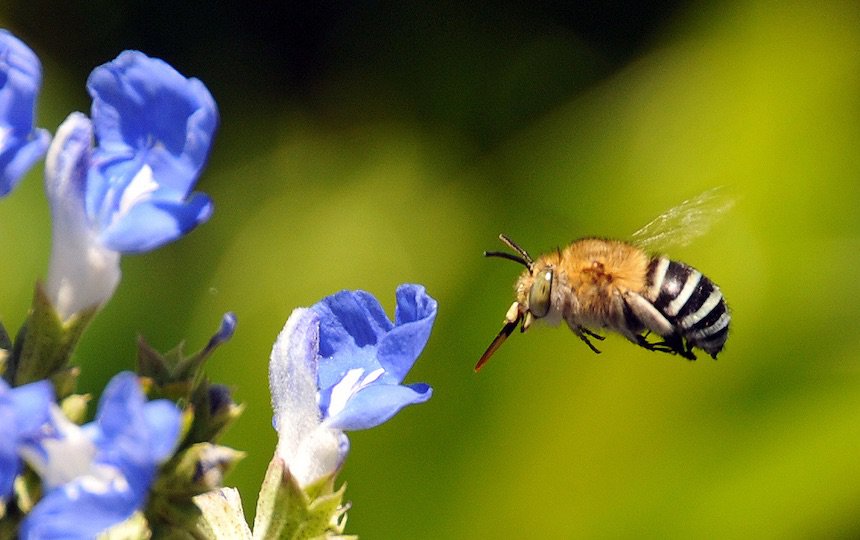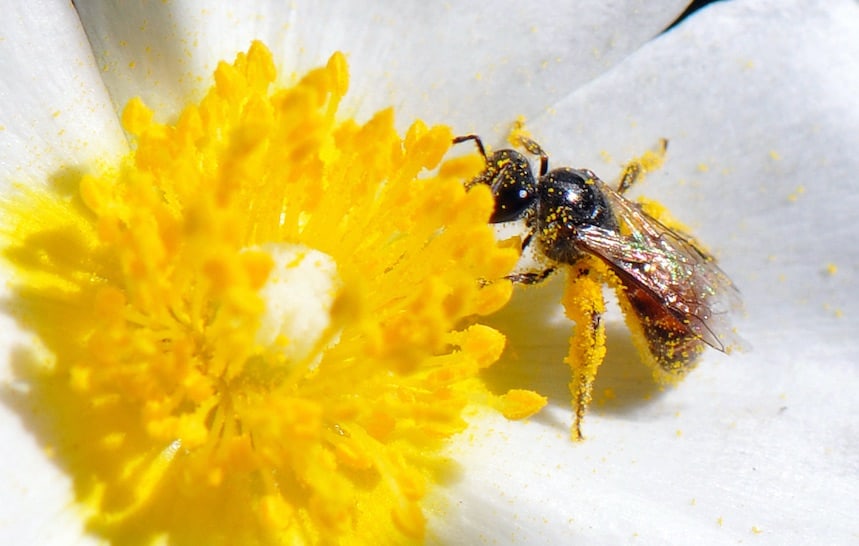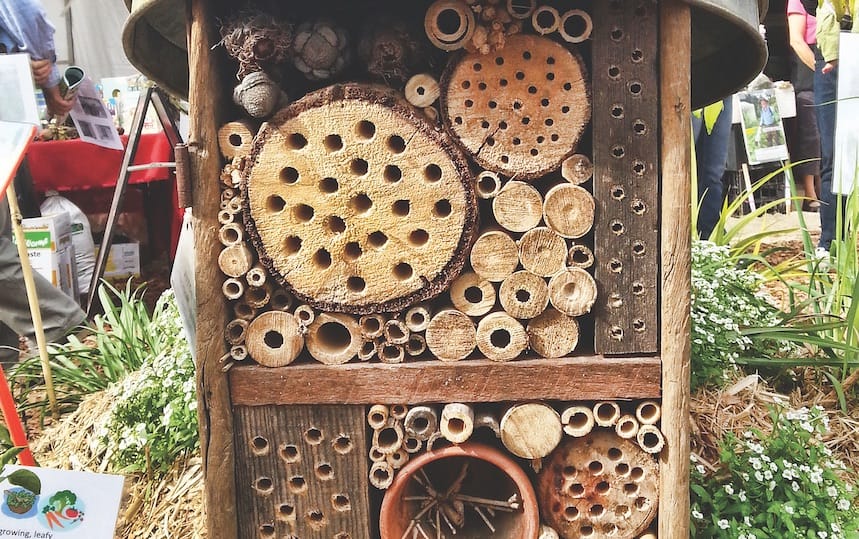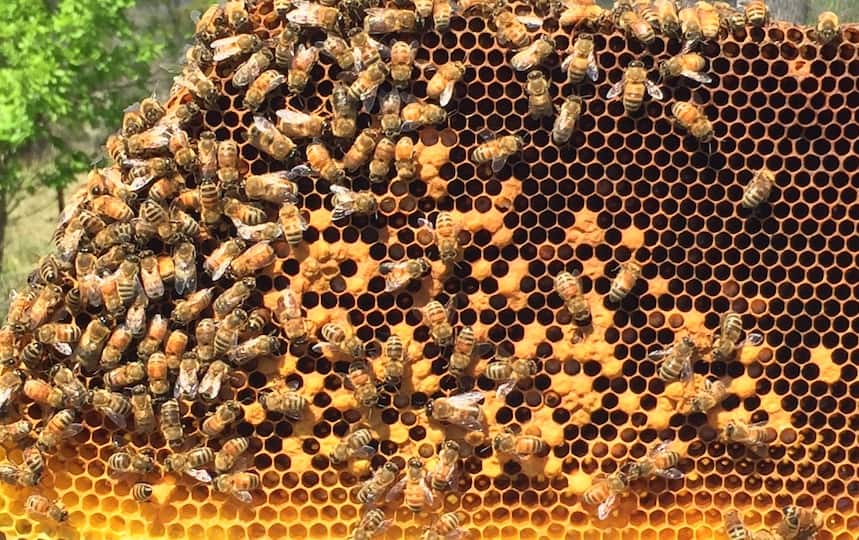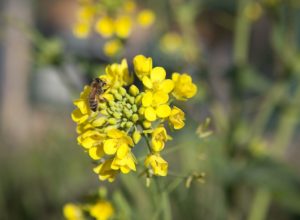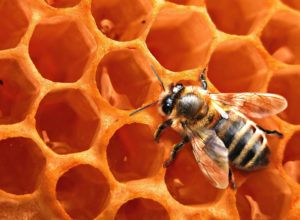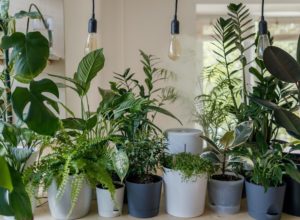With bee populations in decline worldwide, we should all learn how to support native bees’ health by improving our understanding of bee behaviour.
Bees are under threat worldwide. As we urbanise our environments we remove bees’ natural habitat – we create flowerless landscapes when we substitute concrete and lawn for flowering trees and shrubs.
Meanwhile, agricultural practices, such as monoculture, remove the variety of floral resources bees need for good health. Add to these the increasing use of pesticides in crop management and domestic landscapes, and the future for bees looks bleak.
We can support native bee health and populations by improving our understanding of bee behaviour, and how that drives biodiversity. And understanding the importance of bees is about understanding pollination, which facilitates plant sexual reproduction, and the bees’ role in it: biodiversity relies on mixing in the gene pool.
Flowering plants and bees coevolved
Around 100 million years ago, flowering plants (angiosperms) began to evolve. During this time, some wasps began to collect pollen as a protein source to rear their offspring (brood) instead of feeding them other insects; a complex coevolutionary system developed.
Plants are immobile therefore unable to move about to find a mate, and this is where pollination vectors such as insects play an important role.
Plants have evolved ways of attracting pollinators to their flowers by enhancing the sugar concentration in their nectar, producing attractive scents and colours, and providing nectar guides to help insects find the food source. This, in turn, helps the plant to reproduce.
Pollination is the transfer of pollen from the anther (male flower structure) to the stigma (female flower structure). The stigmatic surface is highly nourishing and stimulates pollen germination.
As the pollen tube grows, it carries the male gamete towards the female gamete, within the ovule. Gamete union is called fertilisation, which leads to seed set and results in the production of a plant hormone that stimulates fruit tissue development.
So, good pollination produces good fruit quality and yield. Seed produced through good pollination has superior germination qualities.
Solitary bees
Of the 2,000 Australian bee species fewer than 15 are highly social and colony-forming. Most species are solitary and do not make honey, but they are very important pollinators. Female bees are experts at collecting and transporting pollen and nectar back to their nests, to rear brood.
Most bees are covered with branched, electrostatic hairs, to which pollen grains are attracted. Females have specially adapted structures for transporting pollen, called scopa.
Some species have stiff bristles under the abdomen where dry pollen grains are packed, while others – such as blue banded and teddy bear bees – have scopa on the outside of the hind leg, or on the inside of the hind legs and the abdomen.
One of the most important aspects of these scopal hairs is that they carry millions of dry pollen grains. These are available for transfer from one flower to another as female bees move over the flowers.
Solitary bees live their lives independent of other bees in various nesting substrates. Once a female has mated, she finds a safe nesting place to rear her brood. She forages for floral resources, returns to the nest, unpacks the pollen from her scopa and regurgitates swallowed nectar.
She combines these resources into ‘bee bread’, lays an egg on top, seals the brood cell and leaves the egg to develop alone. This process is repeated many times, until she dies. As she collects her precious cargo of pollen and nectar she performs pollination services.
Some native species
Not all native bees have a common name; however, there are some species that have been grouped together according to either their nesting behaviour or by distinguishing body markings.
- Reed bees are semi-social and generally nest in hollow or pithy- centred reeds or plant stems.
- Carpenter bees burrow into soft wood.
- Resin bees collect plant resin to seal the brood cells.
- Leafcutter bees cut discs from soft young leaves to make their nests.
- Masked bees have distinctive bright markings on their faces.
- Blue banded bees have iridescent hair-stripes (varying from white to dark blue) on their abdomen.
- Teddy bear bees have thick, orange hair.
- Parasitic cuckoo bees lay their eggs in the nests of other (host) bees. Their larvae may consume all of the host- larvae food provisions, or kill and eat the host larvae, or both. Because they do not rear their own brood, females do not need to collect pollen, so they have no scopa. They often have thick hard exoskeletons to protect them against attack from adult host bees.
Benefits of native bees and how to support them
Use flowering plants
One of the best ways to support bees is to plant large numbers of flowering plants: ensuring access to food resources throughout the year supports their reproduction.
Conserve and create habitat
Conserving areas of natural habitat enables female bees to find safe nesting sites,
and helps increase existing populations. Allowing plants to go to seed provides bees with much needed floral resources (and enables seed saving).
Allowing plants, especially those with hollow or pithy stems, to break down in situ, or to slowly rot in piles in isolated corners of the garden, provides nesting sites for some masked bees and reed bees. Other ideas for bee habitat are provided on opposite page.
Don’t use chemicals
Avoiding chemical pesticides in your garden is vital to the health of all bee populations, as well as many other beneficial invertebrates: not using pesticides allows nature to take its course.
For example, beneficial insects – such as wasps, hoverflies, robber flies, predatory shield bugs and lady beetles – and spiders are then able to multiply. These help to control pest species – such as caterpillars, aphids, mites, grasshoppers and other herbivores – by eating them.
Native bees have a symbiotic relationship with a permaculture garden. Many of the non-interventionist techniques that we employ in permaculture support native bee populations. In return they support us by providing valuable pollination services, which produce high crop yield and good quality seed for future crop production.

